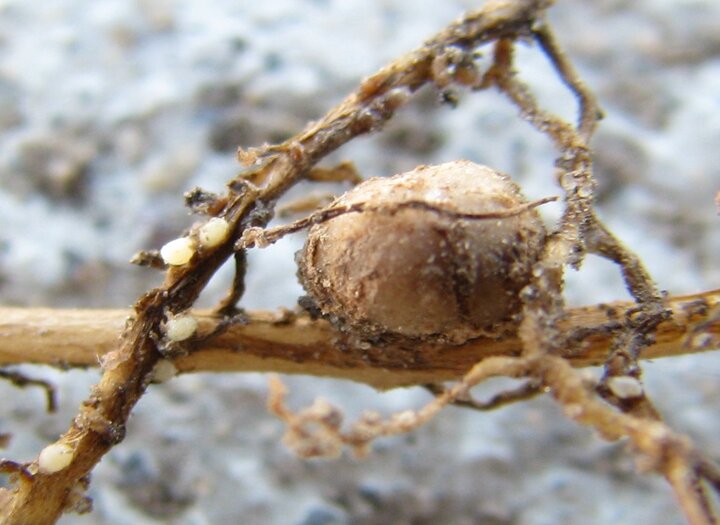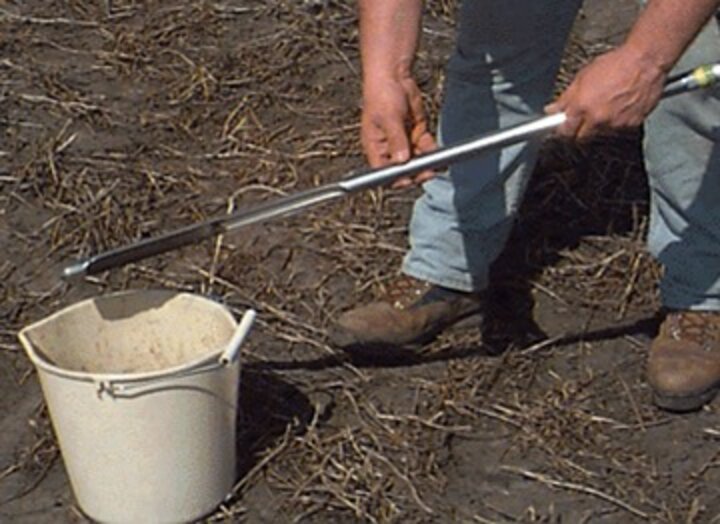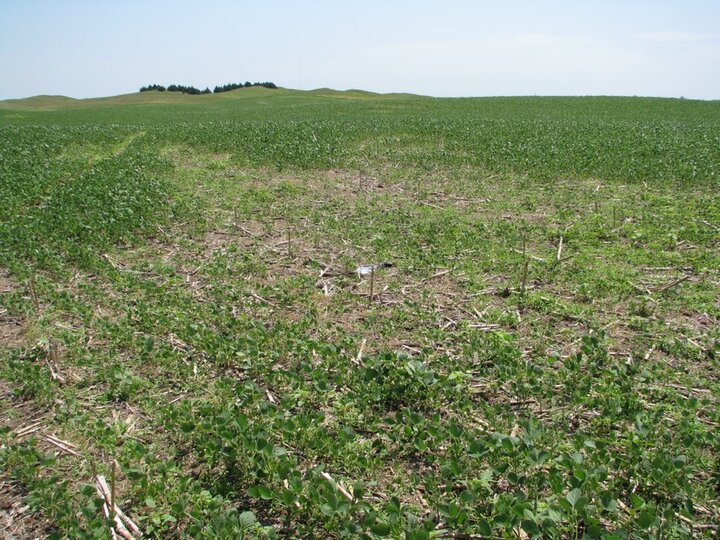This is a busy time of year as we prepare for harvest. For many of us, there’s a lot of “hurry up and wait” time now and during harvest. Time spent waiting in a grain cart or truck on the edges of fields while the combine fills may feel like wasted time and lead to frustration. Why not make the most of that time by using it to collect soil samples for soybean cyst nematode (and other) analyses?
When?
Sampling for soybean cyst nematode (SCN) (Figure 1) is pretty straightforward. Because SCN lives in the upper 8 inches of soil, you can collect a good sample during ANY CROP at ANY TIME of year – at least until the ground freezes and inhibits your ability to use a soil probe.

How?
There’s not much equipment necessary to collect SCN samples.
- You’ll need a simple soil sampling probe, most collecting a 1 inch diameter soil core (Figure 2). Many probes have a handy foot-peg on the side to help push the probe into the soil easier.
- Most people prefer to carry a bucket to carry the soil cores and bags. If the field has not been previously tested, you’ll want to collect at least 15-20 soil cores from a zigzag pattern from across the field. Collect samples to a depth of 8 inches across about 10-20 acres. If there are known problem areas, those spots should be targeted. Break up the cores and mix them well in the bucket (Figure 3) and pour at least 2 cups of the composite soil sample into a bag to be sent to a SCN testing facility. A sealable plastic bag works best, like a zipper-type bag to prevent samples from becoming too dry or you can pick up marked SCN sample bags from your local county Nebraska Extension office.
- Be sure to complete any necessary sample submission form(s) to send with the sample and label the sample bag with your contact information and field name or other ID to be used to report results back to you.
The UNL Plant & Pest Diagnostic Clinic provides SCN analyses at no charge for samples collected from Nebraska fields, courtesy of a grant from the Nebraska Soybean Board.


Where?
SCN has been confirmed in most soybean-producing counties in Nebraska. SCN can cause substantial yield loss with no other visible symptoms. Thus, you may not see yellow, or stunted soybeans where there’s SCN, unless population densities are very high (Figure 4)! Also, keep in mind that anything that moves soil may also move SCN, including wind, water, farming equipment, migratory waterfowl and more. These create higher-risk areas of fields where SCN may first be introduced and could be your best target areas for sampling.
Alternatively, if you’re sampling in an effort to identify the cause of a problem in the field, your strategy may be different. To be confident that the results of your analysis answers the question about whether or not SCN is the cause of a yellow, stunted area of the field, or even for a very low yielding area, it would be best to collect and submit at least 2 samples for comparison from the same field. A composite sample should be collected from within where the “bad” spot is. A second composite sample should be collected from another similar area of the field where the soybeans looked healthier or yielded “better.” The results from those 2 areas can then be fairly compared and you’ll know with more confidence if SCN was the cause of the problem.

Consider sampling these areas:
- Areas of the field where soybean crops yielded less than expected.
- Areas of the field where soybean plants appeared stunted, yellow, and/or defoliated earlier than the rest of the field.
- Low spots in fields.
- Previously flooded areas of fields.
- Just inside field entryways.
- Along field borders
- Areas where sudden death syndrome (SDS) or brown stem rot (BSR) developed
Why Sample?
SCN is still the most damaging soybean pathogen in North America causing greater yield loss than any other. Research has demonstrated that SCN can cause over 40% yield loss. And, SCN can cause up to 30% yield loss with no other visible symptoms, making it an invisible threat. The nematode can cause stunting and yellowing of soybean plants, but this often occurs after the population densities have become very high and become very difficult to reduce.
SCN can impact other diseases. Specifically, the fungal stem rot diseases, sudden death syndrome (SDS) and brown stem rot (BSR), can develop earlier and become more severe when SCN is also present. Although, SCN is not required to start either of these diseases. SDS has been increasing in Nebraska and is usually found in low, wet areas of the field. The fungus causing SDS produces a toxin that is carried to the top leaves where the symptoms first develop. SDS causes yellowing between the veins and rapid defoliation. The fungus also causes severe root rot in affected plants and blue sporulation on the roots may sometimes be visible when they are pulled. See the recent CropWatch article Soybean Diseases Developing in Nebraska for more information.
Results - What do they mean?
Interpreting the results from SCN analyses can be tricky. It’s important to realize that SCN and all nematodes in general, are not distributed evenly in the field. The highest population densities occur in random patches in the field, which is why we may see small round stunted, yellow areas of plants in the field where very high population densities are present. If your results report “0” SCN detected in your sample, keep in mind that low levels of SCN may be difficult to detect in the field and during sample processing. In the field, populations can vary widely within only a few feet. This means that how and where we collect samples can have a big impact on the results we receive.
Detection limits can also vary by lab, too and may be as high as 1000-2000 eggs per 100 cc of soil. The patchy nature of the nematodes make it difficult to get accurate samples and results. And, multiple samples from a field may provide different results, so it’s important to collect cores from as large of an area as is practical.
We recommend continuing to monitor SCN population densities regularly in your fields, especially if soybean yields are less than expected. Sampling every 2-3 years may be needed to document changes in populations and explain yield loss, especially when other possible causes have been ruled out.
We gratefully acknowledge the support from the Nebraska Soybean Board for continuing this important project. Thank you!
For More Information
Please contact us in Nebraska Extension for more information.
Submit samples to the UNL Plant & Pest Diagnostic Clinic and enclose a completed sample submission form requesting SCN analysis.
